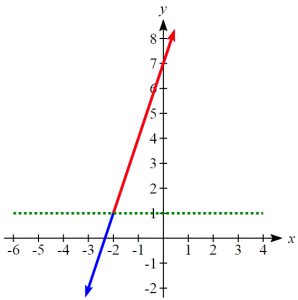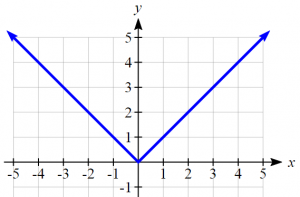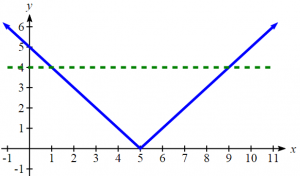2.8 Linear Inequalities in One Variable
When learning about domain and range, you learned about inequalities and using set-builder and interval notation to represent them. In this section, we will explore how to solve linear and absolute value inequalities in one variable. The process is very similar to solve equations, but instead of the solution being a single value, the solution will be an inequality.
Notice that if an inequality is true, like 2 < 5, then these operations result in a true statement as well, just like with equations:
Adding a number to both sides:
2 + 4 < 5 + 4 6 < 9 True
Subtracting a number on both sides:
2 – 3 < 5 – 3 -1 < 2 True
Multiplying a positive number on both sides:
2(3) < 5(3) 6 < 15 True
Dividing by a positive number on both sides:
2/2 < 5/2 1 < 2.5 True
We can use these operations just like when solving equations.
Example Solving a Simple Inequality
Solve ![]()
Subtract 7 from both sides:
![]()
Divide both sides by 3
![]()
This inequality represents the solution set. It tells us that all numbers greater than or equal to -2 will satisfy the original inequality. We could also write this solution in interval notation ![]() .
.
To understand what is happening, we could also consider the problem graphically. If we were to graph the equation
were to graph the equation ![]() , then solving
, then solving ![]() would correspond with asking “for what values of x is
would correspond with asking “for what values of x is ![]() ”. Notice that the part of the graph where this is true corresponds to where
”. Notice that the part of the graph where this is true corresponds to where ![]() .
.
 While most operations in solving inequalities are the same as in solving equations, we run into a problem when multiplying or dividing both sides by a negative number. Notice, for example:
While most operations in solving inequalities are the same as in solving equations, we run into a problem when multiplying or dividing both sides by a negative number. Notice, for example:
2(-3) < 5(-3) -6 < -15 Not True
To account for this, when multiplying or dividing by a negative number, we must reverse the sign of the inequality.
Rules for Solving Linear Inequalities
- You may add or subtract a positive or negative number to both sides of the inequality.
- You can multiply or divide both sides of the inequality by a positive number.
- You can multiply or divide both sides of the inequality by a negative number, but you must reverse the direction of the inequality.
Example Solving an Inequality that Requires Dividing by a Negative Number
Solve ![]()
Subtract 12 from both sides:
![]()
Divide both sides by -4, reversing the sign:
![]()
Simplify the Fraction:
![]()
Or in interval notation: ![]()
Try It Now 1
Solve: ![]()
Example of an Application of Inequalities
A company spends $1200 per day on overhead and labor, and each item they produce costs $5 for materials. If they sell the items for $15 each, how many items will they need to sell each day for their profits to be positive?
While we could solve this problem using equations, it also lends itself to inequalities, since we want the profit to be positive: ![]()
Costs: ![]()
Revenue: ![]()
Profit: ![]()
Solving ![]() :
:
![]()
![]()
![]()
The company will need to sell at least 240 items a day to make a profit.
Compound Inequalities
Compound inequalities are inequalities that consist of more than one part. The most common type is called a tripartite inequality. The basic version looks like this:
![]() .
.
 When we write these it is important that both inequalities point in the same direction and that the “outside” inequality is also true – in this case
When we write these it is important that both inequalities point in the same direction and that the “outside” inequality is also true – in this case ![]() is true, so this is valid. Expressions like
is true, so this is valid. Expressions like ![]() and
and ![]() are not valid notation.
are not valid notation.
The most universal way to solve a tripartite inequality is to:
- Break it into separate inequalities
- Solve each inequality separately
- Combine the solutions if possible
However, if you have only one variable in the middle, you can also solve it by acting on all three parts of the inequality:
Example Solving a Tripartite (Compound) Inequality
a. Solve ![]()
Subtract 5 from all three parts:
![]()
Divide by -3 and switch the direction of BOTH inequality signs
![]()
While this is technically true, it is common practice to write these inequalities with the smaller number on the left using only ![]() or
or ![]() so this answer would be
so this answer would be ![]() or in interval notation
or in interval notation ![]() .
.
b. Solve ![]()
Separate into two inequalities:

So we have that ![]() and
and ![]() so
so ![]() is our final answer, or
is our final answer, or ![]()
Try it Now 2
a. Solve ![]()
b. Solve ![]()
Absolute Value
So far in this section we have been looking at inequalities that are linear. We will now turn to absolute value inequalities. The absolute value function is a piecewise-defined function made up of two linear functions.
Absolute Value Function
The absolute value function can be defined as
![]()

The graph of the absolute value looks like a V:
The absolute value function is commonly used to determine the distance between two numbers on the number line. Given two values a and b, then ![]() will give the distance, a positive quantity, between these values, regardless of which value is larger.
will give the distance, a positive quantity, between these values, regardless of which value is larger.
Examples of Absolute Value
a. Describe all values, x, within a distance of 4 from the number 5.
We want the distance between x and 5 to be less than or equal to 4. The distance can be represented using the absolute value, giving the expression: ![]()
b. A 2020 poll reported 82% of Americans believe that people who are gay, lesbian or bisexual should be protected under civil rights laws with a reported margin of error of 3.1%[1]. The margin of error tells us how far off the actual value could be from the survey value[2]. Express the set of possible values using absolute values.
Since we want the size of the difference between the actual percentage, p, and the reported percentage to be less than 3.1%,
![]()
Try it Now 3
Students who score within 20 points of 80 will pass the test. Write this as a distance from 80 using the absolute value notation.
Solving Absolute Value Equations
To solve an equation like ![]() , we can notice that the absolute value will be equal to eight if the quantity inside the absolute value were 8 or -8. This leads to two different equations we can solve independently:
, we can notice that the absolute value will be equal to eight if the quantity inside the absolute value were 8 or -8. This leads to two different equations we can solve independently:
![Rendered by QuickLaTeX.com \[\begin{array}{lcl} 2x-6=8&or&2x-6=-8\\ 2x=14&\;&2x=-2\\ x=7&\;&x=-1 \end{array} \]](https://ua.pressbooks.pub/app/uploads/quicklatex/quicklatex.com-7e0a552d4582e0a04bc8cf75d9d692b8_l3.png)
Solutions to Absolute Value Equations
An equation of the form ![]() , with
, with ![]() , will have solutions when
, will have solutions when ![]() or
or ![]() .
.
 Watch out for trick questions if you have an equation like
Watch out for trick questions if you have an equation like ![]() , this cannot be solved because an absolute value cannot be equal to a negative number. This equation has no solution.
, this cannot be solved because an absolute value cannot be equal to a negative number. This equation has no solution.
Examples of Absolute Value Equations
a. Solve: ![]()

There are two solutions ![]() or
or ![]()
b. Solve ![]()
Isolating the absolute value on one side of the equation,
![]()
![]()
![]()
Try it Now 4
Find the horizontal & vertical intercepts for the function ![]()
Solving Absolute Value Inequalities
When absolute value inequalities are written to describe a set of values, like the inequality ![]() we wrote earlier, it is sometimes desirable to express this set of values without the absolute value, either using inequalities, or using interval notation.
we wrote earlier, it is sometimes desirable to express this set of values without the absolute value, either using inequalities, or using interval notation.
We will explore two approaches to solving absolute value inequalities:
- Using a graph and technology with test values
- Using solving techniques we’ve learned
We can graph ![]() and
and ![]() using DESMOS or your calculator. Hint: In a TI Calculator, you can use MATH button, and then click the right arrow to NUM and enter as the top function is abs. On a CASIO, you hit OPTN, NUM and then ABS and make sure the expression in the absolute value symbols is in parentheses. On Desmos, you can click the keyboard in the lower left corner and there is an absolute value button.
using DESMOS or your calculator. Hint: In a TI Calculator, you can use MATH button, and then click the right arrow to NUM and enter as the top function is abs. On a CASIO, you hit OPTN, NUM and then ABS and make sure the expression in the absolute value symbols is in parentheses. On Desmos, you can click the keyboard in the lower left corner and there is an absolute value button.
Once we see the graph, we can see the line ![]() and we can see which values of
and we can see which values of ![]()
 make
make ![]() . Using an intersection function on a calculator or solving for
. Using an intersection function on a calculator or solving for ![]() :
:
![]()
We can now see that the values of x for which ![]() is less than or equal to 4 lies between 1 and 9 so our solution is
is less than or equal to 4 lies between 1 and 9 so our solution is ![]()
Another way this could be accomplished is as follows:
- Isolate the absolute value
- If the absolute value is < or
 a positive quantity , then create a compound inequality because the absolute value is between the negative and positive value. (If the absolute value is less than or less than or equal to a negative value, then the inequality has no solutions since absolute values cannot be negative.)
a positive quantity , then create a compound inequality because the absolute value is between the negative and positive value. (If the absolute value is less than or less than or equal to a negative value, then the inequality has no solutions since absolute values cannot be negative.) - If the absolute value is > or
 a positive quantity then create two separate inequalities with OR between them because this means either the expression inside the absolute value is less than the negative value or more than the positive value. (If the absolute value is greater than or greater than or equal to a negative number, then it always has to be true so the solution would be
a positive quantity then create two separate inequalities with OR between them because this means either the expression inside the absolute value is less than the negative value or more than the positive value. (If the absolute value is greater than or greater than or equal to a negative number, then it always has to be true so the solution would be  .)
.)
In this case: ![]()
![]()
![]()
Or [1,9] just like we found before.
Solutions of Absolute Value Inequalities
- To solve
 , solve:
, solve: 
- To solve
 , solve
, solve  or
or 
Example of Absolute Value Inequalities
Given the function ![]() , determine for what x values the function values are negative.
, determine for what x values the function values are negative.
We are trying to determine where ![]() , which is when
, which is when ![]() . We begin by isolating the absolute value:
. We begin by isolating the absolute value:
![]()
![]() When we multiply by -2 to get rid of the
When we multiply by -2 to get rid of the ![]() , it reverses the inequality.
, it reverses the inequality.
Since this is now >, we split ![]() into two inequalities:
into two inequalities:

In interval notation, this would be ![]()
Try it Now 5
a. Solve ![]()
b. Solve ![]()
Try it Now Answers
 or in interval notation
or in interval notation 
- a.
 ;
; ![Rendered by QuickLaTeX.com [-1,5]](https://ua.pressbooks.pub/app/uploads/quicklatex/quicklatex.com-7a4035426059320fb1672a91d16b500c_l3.png) b.
b.  ;
; ![Rendered by QuickLaTeX.com [3,8]](https://ua.pressbooks.pub/app/uploads/quicklatex/quicklatex.com-f8f40341cec246cdf432f6d071bf4d70_l3.png)
- Using the variable p, for passing,

- f(0) = 1, so the vertical intercept is at (0,1). f(x)= 0 when x = -5 and x = 1 so the horizontal intercepts are at (-5,0) & (1,0)
- a.
 ;
; ![Rendered by QuickLaTeX.com [2,3]](https://ua.pressbooks.pub/app/uploads/quicklatex/quicklatex.com-cee3be0ec82bb0a178e596d48cad9f2a_l3.png) b.
b.  or
or  ;
; 
Media Attributions
- graphlinineq
- Reminder is licensed under a Public Domain license
- takenote is licensed under a Public Domain license
- absvaluegraph
- warningsign
- absvalueexample1
- http://www.pollingreport.com/civil.htm, retrieved July 17, 2020 ↵
- Technically, margin of error usually means that the surveyors are 95% confident that actual value falls within this range. ↵

